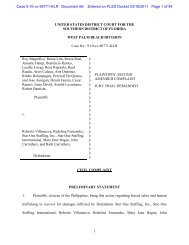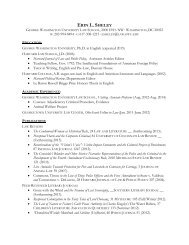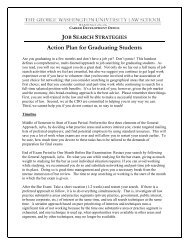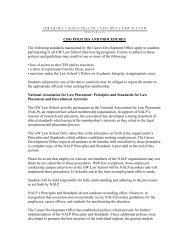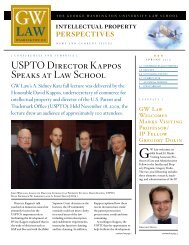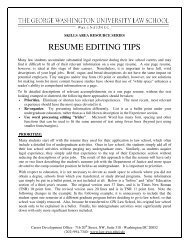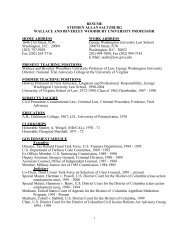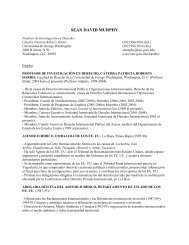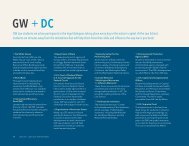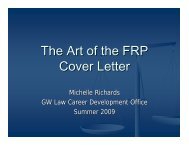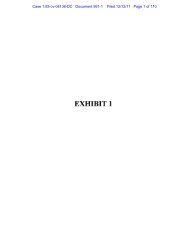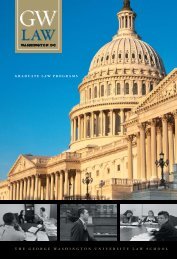CLE Materials for Panel #1 - George Washington University Law ...
CLE Materials for Panel #1 - George Washington University Law ...
CLE Materials for Panel #1 - George Washington University Law ...
Create successful ePaper yourself
Turn your PDF publications into a flip-book with our unique Google optimized e-Paper software.
WILMARTH<br />
4/1/2011 1:11 PM<br />
1000 OREGON LAW REVIEW [Vol. 89, 951<br />
Dodd-Frank generally requires the FDIC to impose a “claw-back”<br />
on creditors who receive preferential treatment if the proceeds of<br />
liquidating a failed SIFI are insufficient to repay the full amount that<br />
the FDIC borrows from the Treasury to conduct the liquidation. 201<br />
However, as noted above, Dodd-Frank authorizes the FDIC to<br />
exercise its powers under the OLA (including its authority to provide<br />
preferential treatment to favored creditors of a failed SIFI) <strong>for</strong> the<br />
purpose of preserving “the financial stability of the United States” and<br />
preventing “serious adverse effects to the financial system.” 202<br />
There<strong>for</strong>e, the FDIC could conceivably assert the power to waive its<br />
right of “claw-back” against a failed SIFI’s creditors who received<br />
preferential treatment if the FDIC determined that such a waiver were<br />
necessary to maintain the stability of the financial markets.<br />
2. Dodd-Frank Does Not Prevent Federal Regulators from Using<br />
Other Sources of Funding to Protect Creditors of SIFIs<br />
Dodd-Frank could potentially be interpreted as allowing the FDIC<br />
to borrow an additional $100 billion from the Treasury <strong>for</strong> use in<br />
accomplishing the orderly liquidation of a SIFI. Dodd-Frank states<br />
that the FDIC’s borrowing authority <strong>for</strong> the OLF does not “affect” the<br />
FDIC’s authority to borrow from the Treasury Department under 12<br />
U.S.C. § 1824(a). 203 Under § 1824(a), the FDIC may exercise its<br />
“judgment” to borrow up to $100 billion from the Treasury “<strong>for</strong><br />
insurance purposes,” and the term “insurance purposes” appears to<br />
include functions beyond the FDIC’s responsibility to administer the<br />
Deposit Insurance Fund (DIF) <strong>for</strong> banks and thrifts. 204 Dodd-Frank<br />
discussed below in Part V.B.2., I believe that the FDIC and the FRB can use additional<br />
sources of funding to support failing or failed SIFIs and their subsidiary banks. However,<br />
I agree with Gordon and Muller that Dodd-Frank contains serious flaws, including its lack<br />
of a pre-funded systemic risk insurance fund. See infra Part V.D.<br />
201 Dodd-Frank Act § 210(o)(1)(B), (D); see also FDIC Proposed OLA Rule, supra<br />
note 171, at 64,178 (stating that Dodd-Frank “includes the power to ‘claw-back’ or recoup<br />
some or all of any additional payments made to creditors if the proceeds of the sale of the<br />
[failed SIFI’s] assets are insufficient to repay any monies drawn from the Treasury during<br />
the liquidation”).<br />
202 Dodd-Frank Act § 206(1); see also § 210(a)(9)(E)(iii).<br />
203 Id. § 201(n)(8)(A).<br />
204 Under § 1824(a), the FDIC may exercise its “judgment” to borrow up to $100 billion<br />
“<strong>for</strong> insurance purposes,” and such borrowed funds “shall be used by the [FDIC] solely in<br />
carrying out its functions with respect to such insurance.” 12 U.S.C. § 1824(a). Section<br />
1824(a) further provides that the FDIC “may employ any funds obtained under this section<br />
<strong>for</strong> purposes of the [DIF] and the borrowing shall become a liability of the [DIF] to the<br />
extent funds are employed there<strong>for</strong>.” Id. (emphasis added). The <strong>for</strong>egoing language




